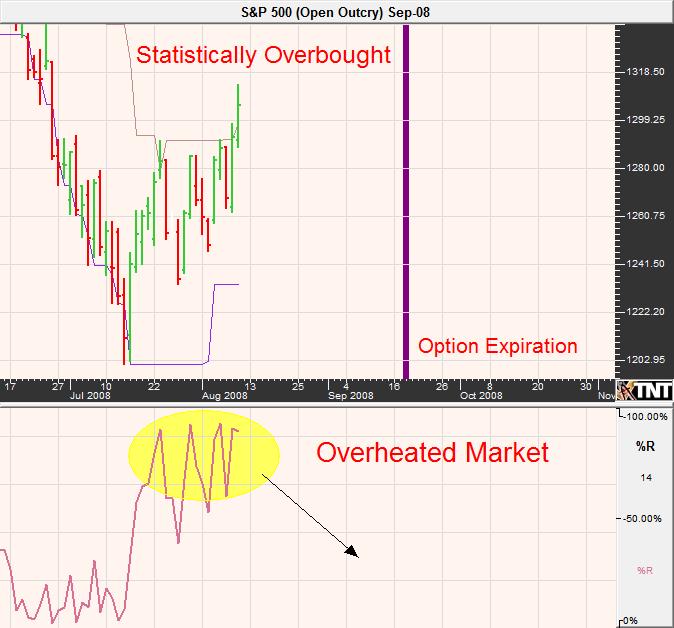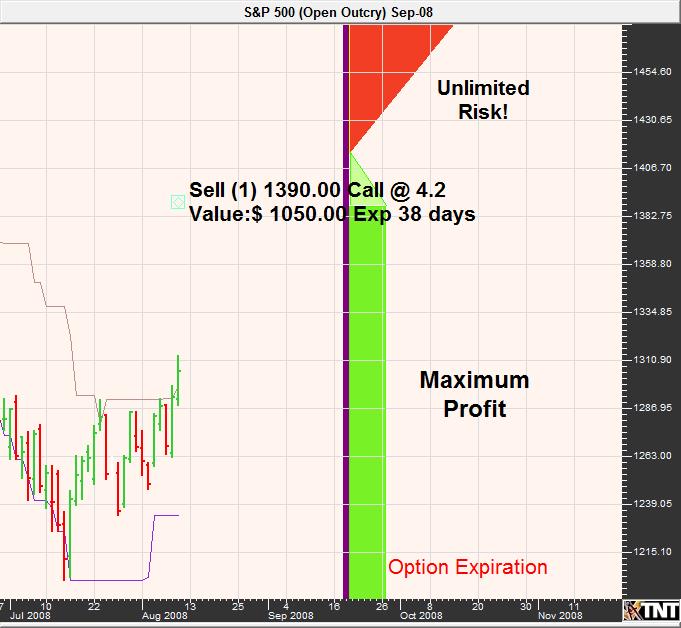Introduction to Options Selling
Options offer traders an unlimited number of strategies with various levels of risk and reward. Unfortunately, many retail traders are stuck in a long option only “rut” and may not be aware of the potential flexibility offered by alternative option strategies. There is certainly a time and a place for buying outright options, but in my opinion most circumstances seem to favor an alternate approach. I believe option selling to be one of the most attractive forms of trading but proper risk management techniques are a must as the risks are high.
Short Option Trading
I have witnessed beginning traders lured to the markets in droves looking to participate in long option strategies. Their attraction stems from the fact that option buyers are faced with the prospects of unlimited profit potential and limited risk in the amount of premium paid plus commissions and fees.
The hazard in this type of mindset is that although one’s losses are limited, it is highly likely that an option buyer will lose some or all of the value of the option. Several studies suggest that more options than not expire worthless, accordingly it seems logical that by simply selling options as opposed to buying them is a preferential strategy.
Contrary to what many might seem to be the case, it is possible to buy a call option and lose money even if the market goes up. This is due to time value erosion and decreases in volatility or demand for the instrument. On the other hand, the seller of that same call could be profitable despite the fact that the futures price increased assuming that time value and or volatility has eroded.
Unlike buying a call, selling a call option is a bearish strategy. Call option sellers believe that the market will decline in the opposite direction of the strike price or at least manage to stay below it.
I have found that it may be preferential for option sellers to initiate positions on a day in which the market is going against the soon to be position. In essence, Call options should ideally be sold during times of elevated market prices and thus elevated call premium. This could mean that the market is approaching the top of a trading range, or simply overbought. Selling against the trend may seem like account suicide, but it can often be justified by inflated premiums.
Short Call Option
Why you would use them?
- If you believe that the market is going down, bearish
- The strength of your belief determines what strike prices you should sell
- Sell out-of-the-money options (higher strike prices) if you believe prices are not going up
- Sell at-the-money options (at current price) if you strongly believe prices are not going up (this isn’t a recommended strategy due to the aggressive nature)
Profit Profile
- The potential profit is limited to the premium collected minus commission and fees
- Your reverse break even point at expiration equals strike price plus the premium collected
- Reverse Break Even = Strike Price + Premium Collected – Commissions and Fees
- The maximum profit occurs if the market is below the strike price at expiration
What is the Risk?
- Exposes trader to unlimited risk; thus, these positions need to be watched closely
- Your losses increase if the market rises faster than the time decay erodes the option value
- The market trading above the reverse break even is equivalent to being short the futures contract
- At expiration your losses increase by one point for each point market moves above the reverse breakeven point
Example
This trade was recommended on The Stock Index Report written by myself and published daily by DeCarley Trading on August 8th. While the recommendation was aimed at those trading the full sized S&P, an e-mini trader could have executed a similar trade with less profit potential and less inherent risk.
The original recommendation called for traders to sell the September S&P 500 1390 call option for $4 in premium or better ($4 in premium is equivalent to $1,000) and would have been filled on the 11th of August at or near the premium requested. In this hypothetical example, we will use a value of $4.2 simply because that is the Black and Sholes value assigned by our charting software.
In figure 1, you can see that although the order was placed on the 8th of August, it took a substantial rally in order to get filled. Patience such as this can lead to missing trades but will also help you to avoid premature entry and potential disaster should the market see a spike in volatility.
Figure 1
This particular trade creates a scenario in which there is a great deal of risk, in fact unlimited risk, above the RBE of the short option. In this case, the RBE is 1394.2 and was calculated by adding the premium collected to the strike price of the short call option. Keep in mind that transaction costs would reduce the amount of premium collected and shift the RBE and risk closer to the market. The amount of premium collected represents the cushion, or the amount in which the trader can be wrong in their speculation that the futures price will be below the strike price at expiration before the trade results in a loss.
The maximum profit is equivalent to the premium collected ($4.2 or $1,050) minus any commissions and fees paid and occurs if the futures price is trading below 1390 at expiration. However, the profit zone of this trade, or where this trades money at expiration, is impressive. This is visually displayed in Figure 2.
Assuming that this short option is held until expiration and it was possible to sell the 1390 call for $4.20 ($1,050 for a full sized contract or $210 for a mini) in premium, it would be profitable with the price of the futures market at any point below the RBE of 1394.2 before considering transaction costs. In other words, the only way for this position to be a loser at expiration is for the futures price to be above the RBE.
It is important to note that although the position is still profitable in between the strike price of the short call and the RBE, the amount of the profit diminishes every tick that the market is trading above the strike price. Once the market surpasses the strike price, it is equivalent to being short a futures contract and exposes the trader to theoretically unlimited risk.
Figure 2
It is easy to see that a short option strategy if implemented effectively can provide traders with an edge over the alternative. In this particular example, the futures price was over 80 full handles away from the strike price of the short call. The distance from the market and the amount of premium collected provides the position with plenty of room for error. After all, I am not perfect and I assume that you aren’t either.
What you should also know is that without proper risk management knowledge and instinct, what looks to be a great strategy can turn into disaster. This is due to the fact that option selling involves unlimited risk and limited profit potential. It is imperative that short option positions are monitored closely, additionally if you aren’t ready for the responsibility and risk involved you should be working with a full service broker familiar with short option trading. Although more options than not expire worthless putting the odds in your favor with short option trading doesn’t produce automatic success. It is critical that risk on the losing trades is properly mitigated before the damage gets out of hand. This is where an experienced broker may come in handy.
Conclusion
The intention of this article was to give you the premise behind the theory of option selling and offer a practical approach to implementation. What you have read is only the beginning when it comes to the practice of premium collection. I hope that I have intrigued your interest enough to open your mind to the possibility of accepting limited profit potential and unlimited risk; sometimes the quantity of wins trumps the quality of a win.
*Futures and Options Trade Involves Substantial Risk of Loss and is Not Suitable for All Investors.
Carley Garner is Senior Market Analyst and Broker with DeCarley Trading, and a columnist for Stocks and Commodities. The co-author of Commodity Options and author of the upcoming book, A Trader’s First Book on Commodities, Garner writes two widely-distributed e-newsletters, The Stock Index Report and The Bond Bulletin. She provides free trading education to investors at www.DeCarleyTrading.com. Garner is a Magna Cum Laude graduate of the University of Nevada Las Vegas.


